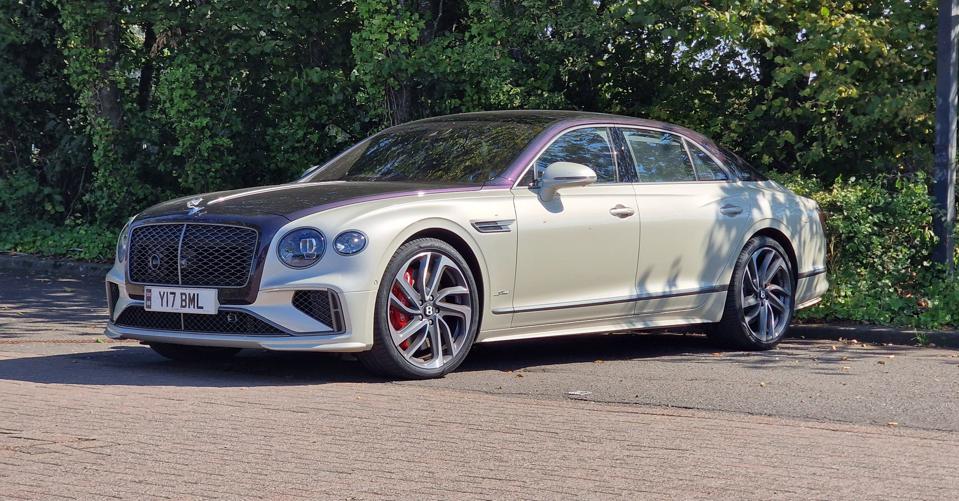How do you make a Bentley Flying Spur more brisk? By adding electric assistance, of course.
Instead of installing a fully-electric powertrain, Bentley has opted for a plug-in hybrid system in its Flying Spur and Continental GT Speed models, referred to by the company as its Ultra-Performance Hybrid system.
Bentley Flying Spur Hybrid Facts And Figures
With the W12 now discontinued, the Flying Spur features a twin-turbocharged V8 engine, producing 592 bhp; however, the engine is paired with a 187 bhp electric motor, resulting in a total output of 771 bhp.
Bentley claims it’ll hit 0-to-62 mph from rest in 3.3 seconds en route to a 177 mph top speed, not bad for a car that weighs as much as a full-grown hippopotamus (3.2 tonnes). Likewise, the 25.9kWh battery delivers a 47-mile range when fully charged and the car will dash to 87 mph on electric-only motivation.
Life With The Bentley Flying Spur Hybrid
My loaner, a Flying Spur Speed, was dressed in what can only be described as one of the most intriguing color combinations I’ve ever seen on a car: Damson (pear) over White Sand. It glistened under the sunlight and snapped necks in busy cities. Stunning is quite simply the word, but it should be for £24,990 ($33,688).
Things were very much the same inside, and I quote the ‘Duo-tone cabin in Damson and Portland leather, finished with Diamond Brushed Aluminium in Dark Tint’, which divided opinion throughout the week, but to me, suited the car perfectly.
It was also equipped with the £7,210 ($9,721) ‘Naim for Bentley’ audio system, a £3,215 ($4,334) Mulliner interior, the £2,000 ($2,696) dark chrome pack and £3,300 ($4,448) 22-inch alloys, all of which pushed the price to £244,100 ($329,053).
The E-range readout showed 25 miles when the car was dropped off and therefore it needed charging before our 260-mile road trip. When plugged into our Easee One 7.4kW charger, the Bentley took one hour and fifty minutes to recover 22 miles of electric range and showed 460 miles of overall range (combined with the petrol engine). When the battery’s completely flat, this increases to two hours and forty-five minutes.
What Bentley has done here is simply magnificent. The previous Flying Spur was no spine smasher, but the PHEV effortlessly glides over potholes and drain covers, something some manufacturers struggle to achieve right after adding motors and batteries. You’ll struggle to feel any difference over the previous non-hybrid Flying Spurs.
It also pulled away so quietly at low speed that people in car parks and busy town centres walked out in front. A quick toot from the Bentley’s chic horn rapidly parted the seas of people who would gawk as we rolled past.
A centre dial allows the driver to select between various drive modes (Comfort, Sport, Bentley and Custom).
Selecting Sport hardens the suspension, opens the exhaust valves and preps the car for take off, and while it weighs almost as much as Buckingham Palace, saying it shifts is certainly an understatement.
Sinking the throttle forces the electric motor and engine to work together; the car then squats before alarmingly rocketing down the road while swapping cogs swiftly but smoothly. It’s a terrifying ordeal. A Racebox recorded a 20 to 60 mph in-gear time of 2.3 seconds, while 0-to-62 arrives in a slightly slower-than-claimed 3.7 seconds. Still, that’s not to be scoffed at.
There are four electric drive settings: EV Drive, the car utilizes its electricity; Hybrid, a balance of engine and electric motivation; Hold, which reserves the battery’s charge; and Charge, which charges the battery via the car’s engine.
One bugbear is that whenever I restarted the car, the drive mode would revert to its default EV Drive setting, leading to rapid battery depletion. However, if I remembered to change the setting back to Hybrid, the car would retain most of its charge under casual driving and return up to 61 mpg on long highway runs.
These mishaps led to the battery running flat halfway through our road trip. An ideal opportunity to test the Charge mode. This mode only becomes available when the car has less than 30 miles of electric range.
Over the 95.4-mile journey back from our road trip, the Flying Spur recuperated 29 miles using only the engine. Of course, this meant the car returned a more Bentley-like 21mpg, but it would make sense to swap between these modes if you are more environmentally conscious. At week’s end, the car returned a 31 mpg average.
On the highway, the Flying Spur returned a hushed 63dB at 70 mph via my sound measuring equipment, placing it just 1dB behind a Rolls-Royce Cullinan II.
Bentley Flying Spur Hybrid Verdict
For once, I’m struggling to find reasons why you shouldn’t buy the Flying Spur, but I can’t. It’s simply brilliant.
The boot’s large enough for two suitcases, if you don’t mind putting your Bentley-branded charging cable bag on the back seat, it’ll return up to 61 mpg in Hybrid mode, and it doesn’t take long to charge.
Then there’s the performance. A luxury barge shouldn’t move like this. It’s mind-bogglingly quick, and that’s another reason why you should buy one. The Bentley Flying Spur PHEV IS the ultimate flying carpet.
Follow me on Instagram.

